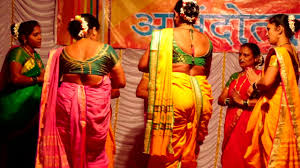Kalasutri Bahuliya and Chamdyacha Bahuliya-Traditional Puppet forms of Maharashtra
 |
| Sri Parasuram Gangavane's Puppets |
 |
| Sri Parasuram Gangavane's Puppets |
 |
| Sri Parasuram Gangavane holding Rakshashi Puppets |
 |
| Sri Parsuram Gangavane holding his two string puppets |
 |
| Sri Parsuram Gangavane's string puppets |
Folk plays or Lok Kala is a way of representing and interpretation of the various aspects of human life and community life through dance, music, and drama. No doubt that in India, folk plays have had an incredible influence on the lives of masses in rural areas mainly, due to the underlined principles of entertainment and education.
The folk performance familiarizes the rural masses to the magical and mysterious world of the universe. In rural and tribal cultures, ritualistic practices are like ritualistic commandments and there are ineradicable marks on the minds of the masses.
Music, dance, drama, folk theatre, or puppetry our country India, had all of it in abundance. So, is the with Puppetry- folk art form of India.
In India, there are mainly four main types of puppets String puppets, Shadow Puppets, Glove puppets, and Rod Puppets. Rest is in combination and sub-categorized based on sizes. String puppets are prevalent in Andhra Pradesh, Assam, Karnataka, Maharashtra, Manipur, Orissa, Rajasthan, Tamil Nadu, and West Bengal. Rod puppets are used in Jharkhand, Orissa, and West Bengal.
Glove puppets are located in Kerala, Orissa Uttar Pradesh, and West Bengal. Shadow puppet traditions have continued in Andhra Pradesh, Karnataka, Maharashtra, Orissa, and Tamil Nadu. However, in different parts of the country, they are given different names. In Telangana state, the shadow puppets have lost their traces.
In this post I am going to share my knowledge on “Kalasutri Bahuliya and Chamdyacha Bahuliya”-Traditional Puppet forms of Maharashtra.
Kalasutri Bahuliya has its origin in 1600 A.D. Also known as Zaiti, it is a Marathi folk form, immensely popular till the twentieth century - ‘Kal’ meaning forefingers of the human hand, ‘Sutri’ meaning black thread and ‘Bahuliya’ meaning puppets. This is a small wooden puppet with moveable arms and shoulder joints. The Kalasutri puppets are mentioned in the 15th chapter of the famous and sacred Gyaneshwari written by Sant Gyaneshwar.
Vishnudas Bhave, the pioneer of modern Marathi theatre, is known to have begun his career with puppet shows that he called Yamapuri. This means ‘City of Yama’ and this is named after the God of Death. Today they have become almost obsolete and are found only among some tribes like the Thakar in parts of Maharashtra.
The traditional Puppet forms of Maharashtra can be classified as under:
- Dayati - Known as Chamdyacha Bahuliya is the Thakkar Aadiwasi form of the shadow puppet theatre
- Zaiti - Traditional string puppetry art of Maharashtra
- Bolkya Bahulya
- Chitrakathi - Paintings of Maharashtra, which are around 400 years old, are called Chitra (picture), Kathi, or Katha (story).
There is the belief that the Kalasutri string puppets came from the Rajasthan-Gujarat area to Maharashtra. There were given patronage by the rulers of Sawantwadi. Sawantwadi is the last big town in Maharashtra located in the middle of the Goa-Maharashtra border. Sawantwadi was the kingdom of the Bhonsle dynasty that is well known for its traditional arts and crafts. Twenty kilometers away from Sawantwadi is Kudal Jilla of Sindhudurg district.
These Thaker community puppeteers of Maharashtra come from the region called Pinguli in the Kudal District. Pinguli ten kilometers away from the town of Sindhudurg known as the puppetry village has been home to praramparik kalakars or traditional folk artists from the mid-eighteenth century onwards.
Again, puppetry is also known as Chitren Dekhavane in the Sindhudurg district of the region.
They are puppeteers who are also storytellers using pictures painted on handmade paper in a unique style called Chitra Katha, play marionette, and also leather puppets. The marionette of Maharashtra is quite small and unique in its style and stage setup. These are mini dolls made up of softwood.
Usually, the man stands behind the stage and performs by manipulating the puppet, while the main artists play instruments like harmonium and the percussionist plays the traditional instrument called the vatavadya and gummat (a clay pot with one end covered by Iguna hide and other ends open)Today it is replaced by tabla and dholak.
According to the character represented, the height varies from 20 to 45 cm. Each figure is divided into two sections. Leather puppets are called Chamadyachya Bahulya or Chamadi Chitre and string puppets are called Kalasutri Bahulya. The performances usually start with an invocation to Lord Ganesh and Saraswati.










Comments
thanks
Greetings from Sphoorthi Theatre!!
Thanks for going through the post "Kalasutri Bahuliya and Chamdyacha Bahuliya-Traditional Puppet forms of Maharashtra" on https://sphoorthi-theatre.blogspot.in/2017/05/kalasutri-bahuliya-and-chamdyacha.html
One way of reaching them is contacting your state Cultural department which has all the artist contact numbers. s most of these artists change their numbers.
Secondly, if you once visit Pinguli you can get their contact details.
Best Regards